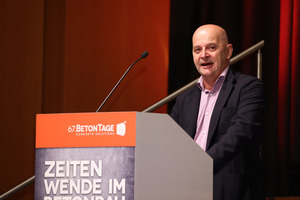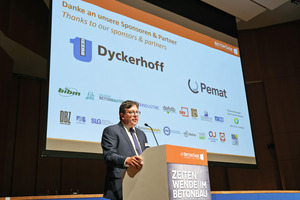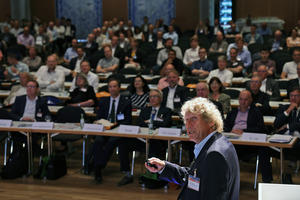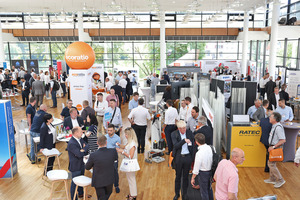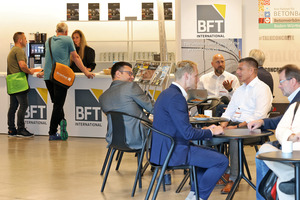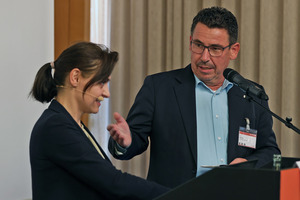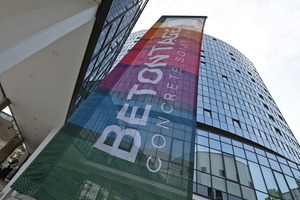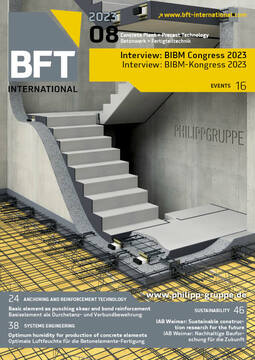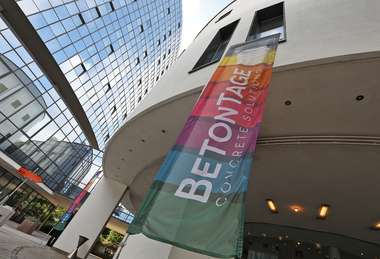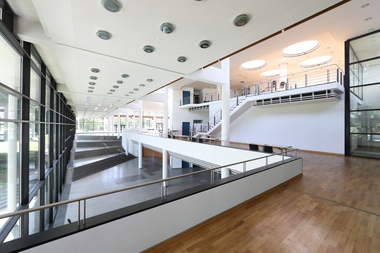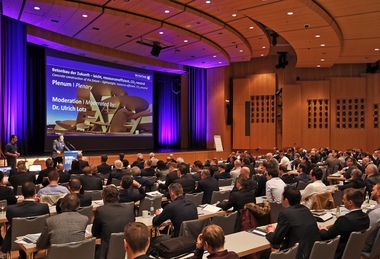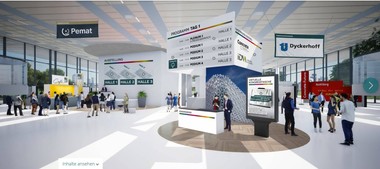67th BetonTage congress: Driving industry transformation
From 20 to 22 June 2023, the 67th edition of the BetonTage congress took place at Congress Centrum Ulm. This year’s industry event was held under the heading of “Turning point in concrete construction”. “Making construction more sustainable is the real challenge! The BetonTage congress is determined to drive this change, foster knowledge transfer and boost innovation,” said Friedrich Gebhart, President of the Baden-Württemberg Association of Concrete and Precast Plants – the trade association that had originally initiated the event, in his opening speech. Presentations from research and practice alike focused on decarbonization, resource efficiency and digitalization. About 1,800 people attended the event and gained insights into the potential of precast concrete construction.
Status quo of the
construction industry
Initially, the focus was set on the current market environment for the construction industry. Increasing energy, fuel and cement prices, rising mortgage interest rates and cuts in housing subsidies are currently clouding the view into the future.
Prof. Bernd Raffelhüschen, of the University of Freiburg, took a closer look at demographics and the related prospects for the real estate industry. By 2050, only 60 of the currently 84 million inhabitants of Germany will still be alive, and about nine million of them will be older than 80. According to him, this would have a negative impact not only on the social security system, but also on the real estate market. The good news is, though, that the number of households will likely continue to rise in the coming years, which is why the demand for construction and housing will by no means decline. In addition, stronger immigration could also have a positive effect on real estate development in the long term, the financial expert explained.
Dr. Ludwig Möhring, of the Bundesverband Erdgas, Erdöl und Geoenergie (BVEG; Federal Association for Natural Gas, Petroleum and Geothermal Energy) based in Hanover, regarded current commodity prices as the “new normal” and thus dampened expectations of cost easing. At the same time, however, this would also drive further advances in efficiency.
Prof. Manfred Curbach, of Technische Universität Dresden, called for a rethink in construction. “We need to build differently and more efficiently: more resource-efficient, lighter, leaner and, most importantly, carbon-neutral.” Given the time remaining until the year of 2045, not one but hundreds of disruptive solutions would have to be implemented, he said. He was particularly critical of the speed with which new developments have been implemented to date. He pleaded for establishing a construction research center and asked for the support of the construction industry. In addition, accelerated approval procedures and an adaptation of the study and training content in the construction sector are needed to master the challenges of climate change.
Decarbonization of the
cement industry
As an energy-intensive, high-emission sector, the cement industry bears a particular responsibility for protecting our climate. Adopting innovative technologies, the industry aims to be in a position to produce climate-neutral cement by 2050. Numerous BetonTage lectures thus dealt with low-clinker or low-carbon cements as well as supplementary cementitious materials (SCMs). Also, carbon capture and utilization (CCU) at the cement plant and carbon capture and storage (CCS) play a major role in decarbonizing the cement and concrete value chain.
A pioneer in this field is Norway, which was also the guest country at this year’s congress and reported on the experience gained so far. Currently, the largest underground carbon storage facility is being built off the country’s west coast, with the aim to demonstrate the feasibility of carbon dioxide storage in the seabed on a large industrial scale and to establish an international transport network to store captured CO2 from across Europe here for 1,000 years. In addition, the world’s first full-scale carbon capture and storage facility will be built at a cement plant in Brevik to capture 400,000 tons of the greenhouse gas per year.
Inspiration for precast plants
Inspiring ideas for precast producers were presented in the segment-specific panels conceived in collaboration with the relevant trade organizations – from structural precast and concrete masonry blocks to pavers and channel systems. The panel dedicated to precast, for example, highlighted various possible applications of recycled concrete in precast construction. Similarly, textile-reinforced precast concrete façades equipped with small photovoltaic panels were presented. In addition, load-bearing and non-load-bearing interior walls for multi-family houses can already be produced using 100% natural aggregate substitutes. A positive effect on the carbon footprint of precast elements can also be achieved through using high-performance concrete, as another example demonstrated. This approach leads to reduced component thicknesses and savings in building material volumes and weight, resulting in a positive effect on carbon emissions during production and site mobilization and logistics. Resource efficiency and decarbonization are also increasingly taking center stage in the design, manufacture and installation of cast stone products. The panel on cast stone showed how this is being implemented in practice using slender components and low-carbon white cement.
The heading “Designing living spaces” provided the backdrop for manufacturers of products for road construction, garden and landscape design to obtain information on the impact of climate change and ways toward implementing climate-neutral concrete block production. This includes, for example, the newly developed mitigation cost calculator as the basis for determining a company’s carbon footprint. The panel on innovative pipe and sewer construction dealt with the new EPDs for pipes and manholes made of concrete and reinforced concrete published by the industry association. Equally interesting was the presentation of an innovative concrete sewer system that is completely cement-free and emits up to 70% less carbon compared to conventional products.
The sustainable transformation of the industry towards climate neutrality also figured prominently on the agenda of the panel on business and law. A precast manufacturer reported on their experience gained in determining the environmental footprint of their products. The Bund Güteschutz Beton- und Stahlbetonfertigteile (Association for the Quality Control and Certification of Concrete and Reinforced Concrete Components) presented the new Sustainable Precast verification system developed specifically for the precast industry. Starting in the fall of 2023, companies in the industry will be able to obtain certification and determine their environmental footprint. In the second part of the program, valuable tips were given on labor and construction law issues, but also on the successful generation of social media leads.
The accompanying exhibition also provided numerous pieces of inspiration for the day-to-day precast business. It was fully booked again this year. Companies from the supplier, equipment and software industries showcased their products and services. Some of them also had the opportunity to inform attendees of their latest developments in the Innovation Forum.
Carbon-reinforced concrete opens up new opportunities
Carbon-reinforced concrete is increasingly finding its way into precast plants and offers great potential for climate-aware construction. In cooperation with Composites United – Netzwerk CU Bau, the organizing team thus again scheduled a separate panel dedicated to this type of material. Among the topics presented were new non-metallic reinforcements, innovative fastening options for façades made of carbon-reinforced concrete, and a research project from Switzerland that aims to promote the use of carbon-reinforced concrete in residential construction.
Quite unsurprisingly, the panel on concrete in structural design also dealt with this material. For example, the first design program for reinforced concrete components upgraded with carbon-reinforced concrete was presented, as well as the new guideline for non-metallic reinforcement published by the German Committee for Structural Concrete (DAfStb). The latter aims to standardize and facilitate construction with carbon-reinforced concrete.
Joining forces with market partners
The “Construction Industry Future Day” has been held since 2020. Organized jointly with the construction industry association, its aim is to engage all stakeholders in the construction value chain, including research institutions, design and architectural practices, precast producers and construction contractors. At the outset, Ulrich Nolting, of InformationsZentrum Beton, gave an overview of the sustainability benefits of concrete. Prof. Lucio Blandini, CEO of Werner Sobek AG and head of the Institute for Lightweight Structures and Conceptual Design at the University of Stuttgart, referred to completed projects in Germany and other countries to show how structures can become lighter and more resource-efficient. In his lecture, Thomas Zawalski, Managing Director of solid UNIT Deutschland, Berlin, emphasized the high innovation potential of mineral building materials because, according to him, they offer the greatest lever for countering climate change.
Various project reports demonstrated what can already be achieved in terms of resource efficiency and greenhouse gas savings: the Fabrik Office, for example, which is currently being built in Munich according to the cradle-to-cradle principle, or Edge East Side, Berlin’s tallest office building, in which concretes with lower embodied carbon were used. In keeping with the circular economy, a current research project is looking into the reuse of precast elements in their entirety. Serial and modular construction also favors precast components because they make it possible to provide urgently needed housing quickly yet in a sustainable manner. For example, slender foundations, multiple formwork use cycles, the use of carbon reinforcement, optimized concrete recipes, and short transport routes can reduce carbon emissions by up to 30% compared to conventional cast-in-place methods.
Passing on the baton within the organizing team
Not just the congress as such, but also the BetonTage organizing team experienced a turning point. Michael Bartmann joined the team on 1 June 2023 to take over Rebecca Kliem’s tasks in his capacity as event management officer. Among other responsibilities, he will be in charge of the exhibition. Likewise, the head of the technical program, Prof. Hans-Joachim Walther, will leave after 21 “Ulm” years. Dr. Ulrich Lotz, Managing Director of FBF Betondienst GmbH, thanked him for his decades of commitment and introduced his successor: Prof. Dominik Kueres, of Munich University of Applied Sciences, will take over responsibility for the technical program of the event. There will certainly be no shortage of topics for the coming years. Not only the precast industry, but also the entire construction sector is undergoing fundamental change. This is why we can look forward to the program of the 68th BetonTage congress, which will be held from 14 to 16 May 2024.
CONTACT
FBF Betondienst GmbH
Gerhard-Koch-Str. 2+4
73760 Ostfildern/Germany
+49 711 32732-322

